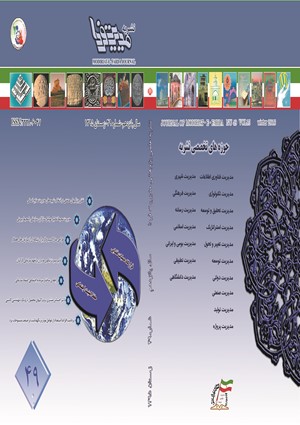یک مدل کاربردی در تشخیص و رتبه بندی فاکتورهای کلیدی موفقیت در پیاده سازی و اجرای نظام مديريت ريسك پروژه (موردکاوی: پژوهشگاه صنعت نفت)
محورهای موضوعی : مدیریت تولید
1 - دانشگاه صنعت نفت
کلید واژه: مديريت ريسك پروژه فاكتورهاي كليدي موفقيت تصمیم گیری گروهی,
چکیده مقاله :
مديريت ريسك پروژه عبارتست از فرايندي نظام مند براي شناسايي و ارزشيابي ريسك ها و توسعه پاسخ ها جهت كاهش تهديد ها و افزايش فرصت ها، در راستاي بهبود عملكرد پروژه. در ادبيات موضوع مديريت ريسك پروژه، برخی فاكتورها براي موفقيت مديريت ريسك، مطرح شده است اما تاکنون تلاشی برای رتبه بندی آنها صورت نگرفته است. مقاله حاضر، یک مدل کاربردی را ارائه می دهد که در آن با استفاده از نظرات خبرگان، فاکتورهای کلیدی موفقیت مدیریت ریسک یک پروژه مفروض، شناسایی شده و رتبه بندی می شوند. قطعا داشتن اطلاعات رتبه بندی این فاکتورها می تواند نگاه مد پروژه را برای تمرکز بر نقاط بحرانی مدیریت ریسک پروژه ه، هدایت نموده و از اتلاف منابع در این زمینه، جلوگیری نماید. مدل رتبه بندی ارائه شده در این مقاله می تواند برای تحلیلگران سایر حوزه های مدیریتی، علاوه بر مدیریت ریسک پروژه نیز سودمند واقع گردد. در انتهای مقاله، مطالعه موردی صورت گرفته با اعمال مدل پیشنهادی، ارائه شده است.
The purpose of project risk management is to improve project performance by systematically identifying and assessing risks, developing strategies to reduce threats and to maximize opportunities. According to our review, some key success factors have previously been identified in project risk management literature, but their importance relative to each other has yet been uncovered. This paper introduces an applicable model to diagnose and to rank the project risk management key success factors of an assumed project, using group decision-making. Surely, having the obtained rank may lead the project manager view toward focusing on critical points of project risk management. The proposed model could be used by the analysts of the other management fields. The paper ends with explaining a case study.
اصغرپور، محمدجواد. (1389). تصمیم گیری گروهی و نظریه بازی ها با نگرش تحقیق در عملیات (چاپ دوم). انتشارات دانشگاه تهران.#
اصغرپور، محمدجواد. (1392). تصمیم گیری چندمعیاره، انتشارات دانشگاه تهران (چاپ یازدهم). انتشارات دانشگاه تهران.#
BI (Business Insurance). (2002). Criteria for Risk Manager of the Year Award. Business Insurance. 36(15): 63.#
Carter B. and Hanock T. Morin J.M. and Robins N. (1994). Introducing RISKMAN Methodology: The European Project Risk Management Methodology, NCC Blackwell Ltd.#
Chapman C.B. and Ward S.C. (2003). Project Risk Management: Processes, Techniques and Insights (2nd Edition), John Wiley.#
Conrow E.H. (2003). Effective Risk Management: Some Keys to Success (2nd Edition). American Institute of Aeronautics and Astronautics.#
Cook, w.d. and Seiford, L.M. (1982). R & D project selection in a multidimensional environment: a practical approach. Journal of the operational research society. 33(5): 397-405.#
Grey S. (1995). Practical Risk Assessment for Project Management. John Wiley & Sons.#
Haimes Y.Y. Kaplan S. and Lambert J.H. (2002). Risk filtering, ranking, and management framework using hierarchical holographic modeling. Risk Analysis. 22(2): 383-397.#
Hampton, J. (2006). Risk Pro Knows Value of Networking. Business Insurance. 40(45): 50.#
Higuera R.P. Gluch D.P. Dorofee A.J. Murphy R.L. Walker J.A. and Williams R.C. (1994). An Introduction to Team Risk Management. Software Engineering Institute.#
Hillson D.A. (2003). Risk management: best practice and future developments, 2nd Congreso Nacional de Gerencia de Proyectos Universidad Nacional de Ingieria (Peru).#
Hulett D.T. (2001). Key characteristics of a mature risk management process. Fourth European Project Management Conference (UK).#
Kerzner H. (2013). Project Management: A Systems Approach to Planning, Scheduling, and Controlling (11th Edition). Wiley.#
Kliem, R.L. and Ludin, S. (1997). Reducing Project Risk. Gower.#
Kontio J. (2001). Software Engineering Risk Management: A Method, Improvement Framework and Empirical Evaluation. Ph.D. Dissertation (Helsinki University of Technology).#
Kwak Y.A. and Stoddard J. (2003). Project risk management: lessons learned from software development environment. Technovation. 24: 915-920.#
Lenckus, D. (2005). To Ensure Success, Get Backing from Management. Business Insurance, 39(19): 9–13.#
McDonald, C. (2004). ERM Success Checklist. National Underwriter/Property & Casualty Risk & Benefits Management, 108(10): 26.#
NAO (National Audit Office). (2000). Supporting innovation: Managing risk in government departments. A Report by Comptroller and Auditor General.#
PMI (Project Management Institute). (2013). A Guide to the Project Management Body of Knowledge. Newtown Square.#
Roberts B.B. (2001). Lessons learned: round 2. INCOSE Symposium on Risk Management (USA).#
Seyedhoseini S.M. Noori S. and Hatefi M.A. (2008). A gap analysis on the project risk management processes. Kuwait Journal of Science and Engineering. 35(1B): 217-234.#
Simister T. (2000). Risk management: the need to set standards. Balance Sheet Journal. 8(4): 9-10.#
Vaughan E. and Vaughan T. (2001). Essentials of Risk Management and Insurance. John Wiley & Sons.#
Williams C. Arthur J.R. Smith M.L. and Young P.C. (1998). Risk Management and Insurance (8th Edition). McGraw-Hill.#
Yaraghi, N. and Langhe, R.G. (2011). Critical Success Factors for Risk Management Systems. Journal of Risk Research. 14 (5): 551-581.#


